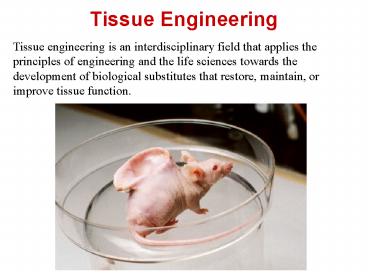Tissue Engineering PowerPoint PPT Presentation
1 / 46
Title: Tissue Engineering
1
Tissue Engineering
Tissue engineering is an interdisciplinary field
that applies the principles of engineering and
the life sciences towards the development of
biological substitutes that restore, maintain, or
improve tissue function.
2
Why Tissue Engineering?
- Lack of donor tissues/organs for transplantation
- Lost of potency in vivo for acellular polymer or
metal substitutes - Use of autogenous cells no rejection or pathogen
transmission
3
(No Transcript)
4
Key Factors involving tissue engineering
Scaffold (ceramics, polymers)
Cell Culture (stem cell, osteoblast, chondrocyte,
hepatocyte)
Tissue/Organ regeneration
Signaling Molecules (Growth Factors, proteins)
5
Need for Replacement
- Skin - 3 million procedures per year
- Bone - 1 million procedures per year
- Cartilage - 1 million procedures per year
- Blood Vessel - 1 million procedures per year
- Kidney - 600 thousand procedures per year
- Liver - 200 thousand procedures per year
- Nerve - 200 thousand procedures per year
- Can anyone guess how much all these replacements
cost per year?
gt100 billion
6
Clinical Needs
- Cardiovascular
- Myocardial infarction
- Stroke
- Bone
- Non-union fractures
- Tumor resections
- Nervous
- Spinal Cord Injury
- Degenerative diseases
7
- Traditional Implants (hip replacement)
- Poor biocompatibility
- Mechanical Failure (undergo fatigue, wear,
corrosion) - Transplants
- Rejection
- Disease transmission
- Supply ltlt Demand
8
Tissue Engineering
- Repair/replace damaged tissues
- Enhance natural regeneration
Cell Source Embryonic stem cells Adult stem
cells Progenitor cells
ECM Metals Ceramics Synthetic polymers Natural
polymers
Signals Growth factors Drugs Mechanical forces
9
Stem and Progenitor Cells
- Isolation/Identification
- Signature of cell surface markers
- Surface adherence
- Transcription factors
- Classifications
- Embryonic Stem Cells
- Adult Stem Cells
- Induced Pluripotent Stem Cells
10
What do we want in a scaffold?
- 1. Biocompatible
- 2. Biodegradable
- 3. Chemical and Mechanical Properties
- 4. Proper architecture
11
Tissue Engineering Scaffold
- The biocompatibility of a scaffold or matrix for
a tissue engineering product refers to - the ability to perform as a substrate that will
support the appropriate cellular activity,
including the facilitation of molecular and
mechanical signalling systems, in order to
optimise tissue regeneration, without eliciting
any undesirable effects in those cells, or
inducing any undesirable local or systemic
responses in the eventual host.
12
Scaffolds and Matrices
- Synthetic degradable polymers
- Natural biopolymers (proteins, polysaccharides)
- Bioactive ceramics
- Degradable / non degradable hybrids
- Heterogeneity / anisotropy
- Surface active / molecular release
- Manufacturing technologies
13
Polymers in TE
- Natural
- Derived from ECM
- preprogrammed
- Generally biocompatible
- Biological degradation mechanism
- - not made, purified
- Synthetic
- Made by controlled process
- /- Range of biological responses
- /- Range of degradation
- Established production protocol
14
Architecture
- Pore size
- Average diameter of pores
- Porosity
- Porosity volume/total volume
- Interconnectivity
- Porogens (melt molding)
15
Important scaffold variables
- Surface chemistry
- Matrix topography
- Cell organization, alignment
- Fiber alignment -gt tissue development
- Rigidity
- 5-23 kPa
- Porosity
- Large interconnected
- small disconnected
16
Models for Tissue Engineering
- In vitro differentiation
- Construct tissues outside body before
transplantation - Ultimate goal
- Most economical
- Least waiting time
- In situ methodology
- Host remodeling of environment
- Ex vivo approach
- Excision and remodeling in culture
Optimize stem cell differentiation and
organization
Combine physical and chemical factors
17
(No Transcript)
18
Delivery Methods
- Injectable stem cells
- Cells or cell-polymer mix
- Less invasive
- Adopt shape of environment
- Controlled growth factor release
- Solid scaffold manufacturing
- Computer-aided design
- Match defect shape
19
Ideal scaffold characteristics
- Three dimensional and highly porous with an
interconnected pore network for cell/tissue
growth and

